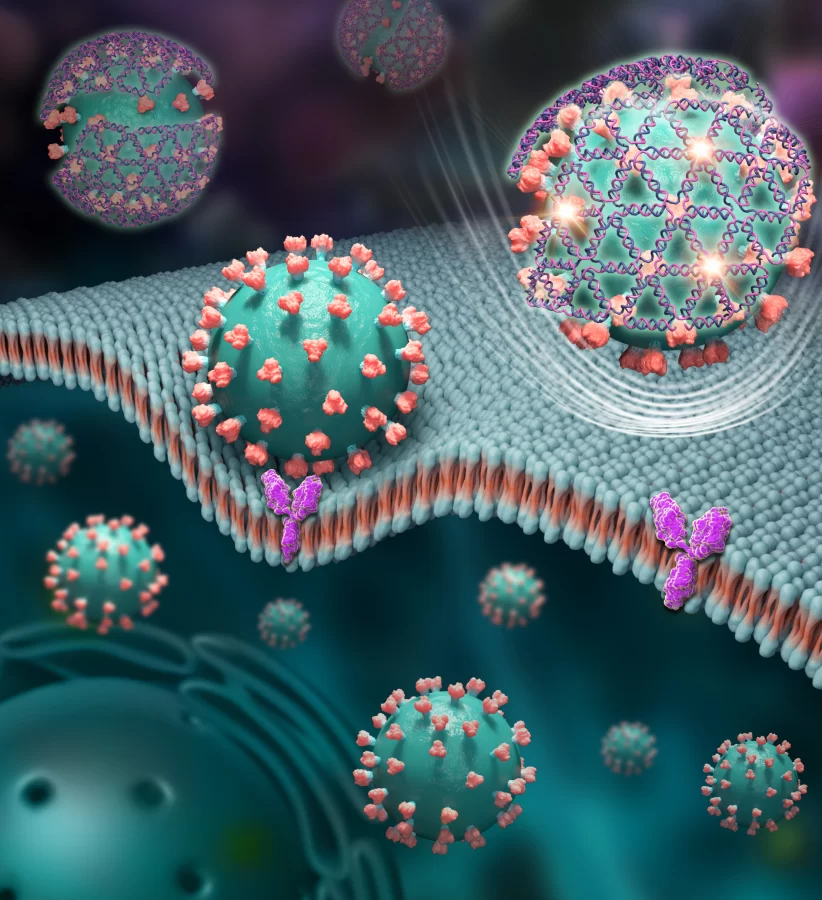UI researchers use DNA to develop alternative COVID-19 test
Oct 21, 2022
COVID-19 testing can currently be done with either a PCR test or an antigen test. However, University researchers have been testing a new method that would combine the benefits of both methods through the use of DNA.
PCR tests are more accurate, but they require several trained professionals and are also slower and more expensive than antigen tests, which sacrifice some accuracy to be cheaper and faster. Through the use of DNA nets — nanostructures made of strands of DNA — this new testing method would be quick, cheap and highly accurate.
Xing Wang, associate professor of bioengineering and research team leader of the project, explained how DNA net testing combines these advantages.
“It’s much cheaper for the DNA net test,” Wang said. “We can go from the sample to the result in five to 10 minutes, and the cost is about $1.50.”
In addition to detecting COVID-19, this method would also work to block infection by the virus. Wang explained how DNA nets are able to do so.
Get The Daily Illini in your inbox!
“If you look at the structure closely, there is a hollow space created by the DNA net, and this space is large enough for the antibody generated by our immune system to still attack the spike protein to eventually fulfill the neutralization (of the virus),” Wang said.
COVID-19 virus cells have spike proteins on their surfaces, which stick out and bind with uninfected cells to infect them. The DNA nets are designed in a way that matches the pattern of these proteins in a manner that lets them bind with the virus cell. Once this has occurred, the DNA nets release a fluorescent signal that can easily be detected by handheld devices called fluorometers.
These capabilities were shown in a paper published in the Journal of the American Chemical Society. Neha Chauhan, postdoctoral researcher at the University and the first author of the paper, used Legos to explain the method.
“You take Legos, small parts, and you design a big structure,” Chauhan said. “We use DNA strands, double-stranded DNA strands, and we do a net-shaped structure. That’s what we call DNA nanostructures. And then on these nanostructures, we place aptamers, which you can think of as a molecule that can detect the proteins of the virus.”
Chauhan said something that distinguishes this method from other methods is that it can detect an intact virus.
“The focus of our project was to develop a platform that can detect the intact virus, so we don’t have to use virus slicing or stuff like that,” Chauhan said. “And that can differentiate whether a person is actively infected with COVID-19, is fine or has recovered from COVID-19.”
While this is the first time this method has been used to potentially combat COVID-19, this is not Wang’s first time working with DNA nets. In January 2020, a paper by the team was published in Nature Chemistry about the use of similar technology to combat the Dengue virus. Wang said that once the pandemic started, they focused on COVID-19.
“So, we didn’t predict the pandemic, but our technology came out in terms of the publication in Nature Chemistry as a cover story in January 2020,” Wang said. “Of course, the paper was a process before the pandemic, right. So, we didn’t predict it, but we quickly adapted our technology to the SARS-CoV-2 study.”
Wang said he was interested in developing this technology because of the several pandemics throughout recent history, especially in China.
“The real interest is that the problems we have gone through during this pandemic have already (happened) many times previously, for SARS-1 in China, mainly in China for MERS, for the influenza pandemic, for the HIV pandemic,” Wang said. “So, it has been repeated many times. It’s just never happened at this scale.”
While the paper focused on the potential of DNA nets to be used against COVID-19, Chauhan said that an important aspect of the research is that it can be used for other viruses, too.
“It’s not just limited to COVID-19,” Chauhan said. “It can be used, or it can be very easily translated for the detection of other viruses. Our lab actually works on developing these kinds of nanostructures for influenza detection, for HIV detection and for HPV detection. So there are various other viruses that can be detected using similar technology.”
Wang echoed this sentiment, saying that the end goal is for this technology to detect more than just viruses.
“That’s our interests, starting from virus, but our interest is not confined to just (this),” Wang said. “Our end goal is going to be cancer treatment and cancer diagnosis, continued diagnosis, which means we use the same structure for both diagnosis and therapy.”






